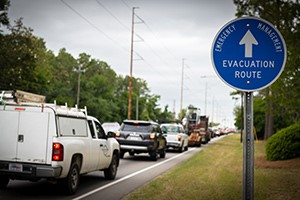Evacuate Safely When Disaster Strikes

Hot summer weather is responsible for an increase in natural disasters, from dry conditions sparking forest fires to warmer seas making hurricanes more likely. Every disaster is different, so having a plan and knowing when to evacuate are crucial for your safety when an emergency occurs.
Plan Ahead
The best time to begin planning how to evacuate is long before a disaster strikes. In some emergencies, you may have time to plan your evacuation, but others may be more urgent.
- Learn your region’s weather patterns and what disasters are most likely to occur.
- Get to know the transportation options in your area, as well as major and alternate routes of travel.
- Establish places you can go in an emergency, including homes of friends and family.
- Keep up-to-date information on local shelters for emergency stay, including animal shelters if you have pets.
- Make a household plan that includes ways to connect if you get separated, such as a designated meeting spot.
- Prepare an emergency bag of necessary supplies and keep it in an accessible spot. Visit the Ready campaign at https://www.ready.gov/kit for ideas on what to include.
- Ensure phones and other devices are charged and have portable power banks ready.
- If you have a car, make sure it’s travel ready: get regular maintenance, keep the gas tank full, and equip it with an emergency supply kit.
Know When to Go
Every disaster follows a different timeline, so keeping up with new information from local authorities will help you determine when you should leave.
- Local public safety officials will give instructions and shelter information through radio and TV stations as well as text alerts and FEMA’s mobile app. Have a battery-powered radio available in case service is unavailable for other technologies.
- Take the recommended evacuation routes; others may be blocked.
- Leaving early, before an evacuation order, may be necessary to avoid severe weather.
- If there is time beforehand: lock windows and doors, unplug electric appliances, turn electrical and water systems off, and offer neighbors assistance.
When to Return
After disastrous conditions have passed, travel may still be difficult or risky. Do not try to return home until public safety officials declare it’s safe.
- To learn about travel conditions, consult local officials both near your home and where you’re sheltering.
- Let your friends and family know your travel plans.
- Environmental hazards may still exist for your return trip. Prepare similarly to evacuation: charge devices, fill your gas tank, and replenish your emergency bag.
- Watch for and avoid debris and high water on your travel route. Downed power or utility lines are particularly dangerous and should be reported to a utility company.
- Check for hazards before re-entering your home, such as structural damage, gas, and mold.
- Disruptions to local services and daily activities are common in a disaster-affected area. Continue to monitor official channels for new information.


